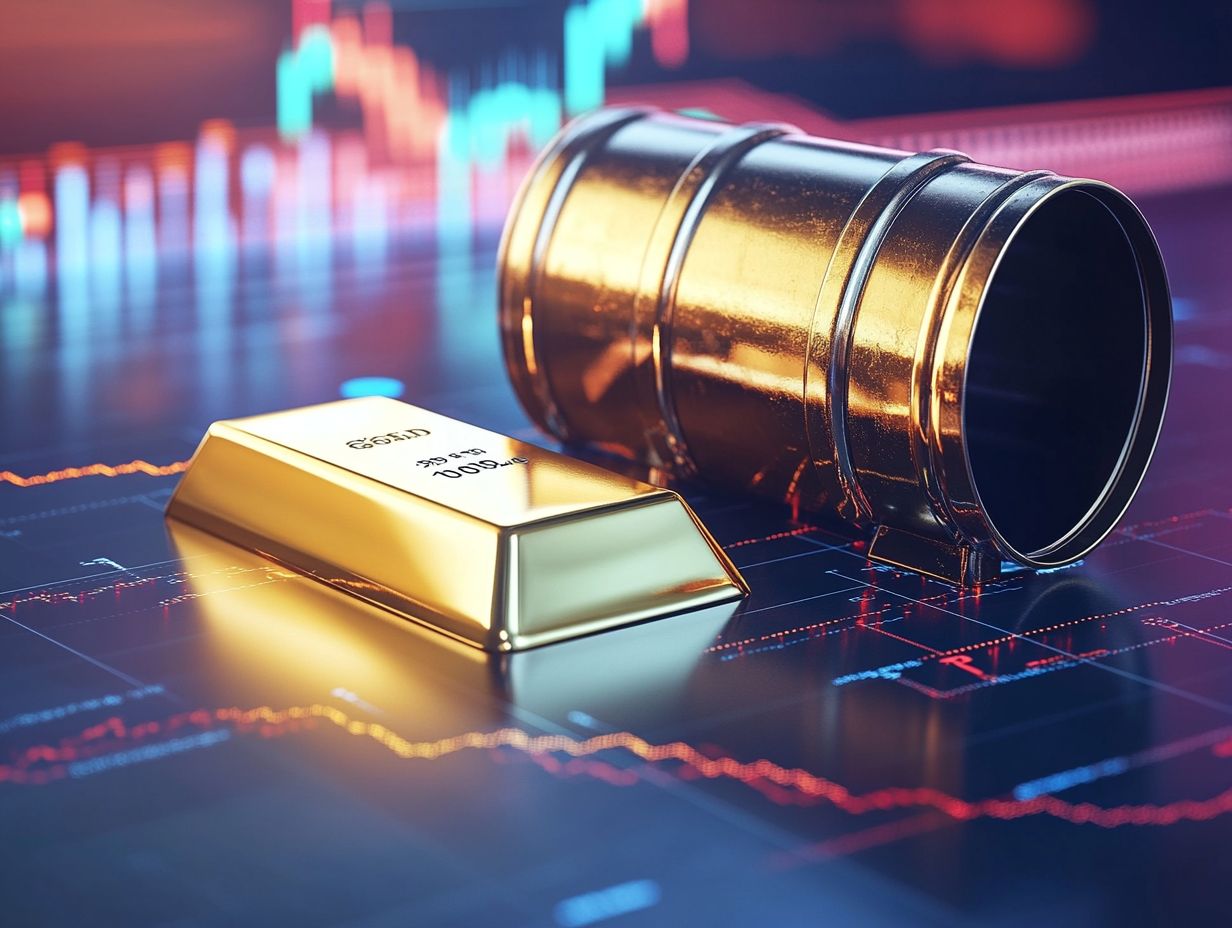The Relationship Between Gold and Oil Prices
Gold and oil stand as two of the most significant commodities in the global market, each acting as a barometer for economic health and stability.
Their prices are swayed by a multitude of factors, ranging from economic indicators to geopolitical events. This creates a complex interplay that can influence everything from inflation rates to your investment strategies.
This article delves into the dynamics of these markets, examines their historical connections, and assesses their current conditions. It also discusses how they shape the global economy and investment landscape.
Whether you’re a seasoned investor or simply curious about market trends, grasping the relationship between gold and oil is essential for navigating the nuances of today s financial world.
Contents
- Key Takeaways:
- Overview of Gold and Oil Prices
- Factors Influencing Gold and Oil Prices
- The Historical Relationship Between Gold and Oil Prices
- What s Happening Now in Gold and Oil?
- Impact of Gold and Oil Prices on the Global Economy
- Investing in Gold and Oil
- Frequently Asked Questions
- What is the relationship between gold and oil prices?
- Why do gold and oil prices have an inverse relationship?
- How do oil price changes affect gold prices?
- Do all oil price changes affect gold prices?
- Is the relationship between gold and oil prices always the same?
- Do gold and oil prices always move in opposite directions?
Key Takeaways:

- Understand how economic, political, and geopolitical factors influence gold and oil prices, making them volatile and unpredictable.
- Recognize the historical correlation between gold and oil prices, with both serving as safe-haven assets in times of economic uncertainty.
- Stay updated on the constantly changing gold and oil markets, as recent price movements and predictions indicate potential opportunities for investors.
Overview of Gold and Oil Prices
The overview of gold and oil prices offers deep insight into the fluctuations of these vital commodities in financial markets. As two of the most significant pillars of the global economy, their prices demand your attention, especially as you navigate market dynamics and trends.
Gold, frequently regarded as a safe-haven asset, tends to respond distinctly to various market conditions. In contrast, oil prices are swayed by energy policies, geopolitical tensions, and the intricate dance of global supply and demand.
Understanding these nuances will empower you to make smarter investment choices today!
Explanation of Gold and Oil Markets
The gold and oil markets play a crucial role in shaping the commodities landscape. They are traded in specialized exchanges around the globe, mirroring the economic conditions and investor sentiment that underlie them.
These markets are influenced by a diverse array of participants, from institutional investors and hedge funds to retail traders. All of these groups react to global events and economic indicators. Trading platforms provide real-time data essential for making informed decisions.
Traders discover prices in these arenas through the dynamic interplay of supply and demand. This often results in price volatility driven by geopolitical tensions, currency fluctuations, and changes in inventory levels.
For you, understanding the significance of these commodities is vital if you aim to navigate the complexities of financial markets and manage risks effectively.
Factors Influencing Gold and Oil Prices
Grasping the factors that influence gold and oil prices is essential for any investor aiming to master the complexities of the commodities market. These prices don t move in a vacuum; they are affected by a sophisticated interplay of economic, political, and geopolitical elements.
Economic, Political, and Geopolitical Factors
Economic stimulation and geopolitical tensions are crucial factors that significantly influence the prices of gold and oil. They serve as signs of the economy’s health and investor demand within the global economy.
When central banks take bold actions, such as slashing interest rates or engaging in asset purchases, it can create heightened inflation expectations. This often drives investors toward gold, viewing it as a safe haven during uncertain times.
On the flip side, recent geopolitical developments, such as ongoing conflicts in the Middle East or trade disputes among major economies, can inject volatility into the oil markets. A notable illustration is the Russia-Ukraine conflict, which caused oil prices to soar by over 60% at its peak earlier this year, primarily due to supply disruptions.
These dynamics clearly illustrate how closely intertwined gold and oil prices are with broad economic narratives, including the relationship between silver and gold prices.
The Historical Relationship Between Gold and Oil Prices

By examining the historical relationship between gold and oil prices, you uncover significant correlations that provide valuable insights into their behavior across various market conditions.
This understanding is essential for conducting thorough market research and effectively evaluating price ratios.
Analysis of Past Trends and Correlations
Analyzing past trends and the correlations between gold and oil prices reveals recurring patterns and price movements that can significantly inform your strategic decisions in the financial markets.
By exploring historical data, you can uncover how global political events, such as conflicts or economic sanctions, have impacted the trajectory of both commodities. For instance, during times of heightened global political tension, you often see oil prices surge, which in turn prompts a parallel increase in gold as investors flock to low-risk investments. Understanding the gold-silver ratio can further illuminate these dynamics.
Recognizing these relationships not only aids in predicting future movements but also enables you to make informed choices, particularly amid market volatility.
Understanding these dynamics is crucial; it allows you to anticipate potential fluctuations and craft strategies that align with your risk tolerance and investment goals, ultimately enhancing your potential for returns.
What s Happening Now in Gold and Oil?
The current landscape of the gold and oil markets reveals recent price fluctuations indicative of prevailing market conditions and investor sentiment, shaped by a blend of global economic influences and localized developments.
Recent Price Movements and Predictions
Recent price movements in the gold and oil markets have ignited discussions about future predictions. Analysts are considering various factors of market volatility and financial policies that could sway these commodities.
As a market participant, you must watch geopolitical tensions closely, along with shifting demand dynamics and interest rate adjustments all elements that contribute to changing valuations.
For instance, recent fluctuations in consumer demand for oil, sparked by signs of economic recovery, have led to speculation about supply constraints that could trigger potential price surges.
With such uncertainties in the air, it s wise to adopt a more cautious approach. Some investors may lean towards hedging strategies, which are ways to protect their investments against price drops. The evolving landscape of financial regulations may greatly influence how investors feel, nudging you to reassess your asset allocations in light of these developments.
Impact of Gold and Oil Prices on the Global Economy
The influence of gold and oil prices on the global economy is far-reaching, affecting numerous industries. These fluctuations touch everything from consumer prices to economic stimulation, ultimately shaping purchasing power in various countries.
Recognizing this interconnectedness allows you to better understand the broader economic landscape and its implications for your financial decisions.
Consider reassessing your investments now to better align with the changing markets!
Effects on Different Industries and Countries

The effects of gold and oil prices ripple across various industries and countries, shaping inflation rates, influencing consumer behavior, and driving overall investor demand in the global economy.
In the energy sector, when oil prices fluctuate, the implications for production costs and profitability can be profound. The manufacturing industry often adjusts its inventory levels in response to these price changes.
Take Saudi Arabia and Russia, for example, countries that heavily rely on oil revenues. They implement fiscal policies designed to buffer their economies against the shocks of fluctuating oil prices. Meanwhile, nations like South Africa and Australia, which hold significant positions in the gold market, adopt strategies such as currency stabilization and export diversification to lessen the impacts of price volatility.
These adaptive approaches underscore the intricate relationship between commodity prices and economic resilience across various global contexts.
Investing in Gold and Oil
Investing in gold and oil demands a meticulously crafted strategy that carefully considers factors like asset preservation, potential for return generation, and the natural price fluctuations of commodity prices.
You can confidently tackle these markets by crafting a solid strategy. A comprehensive approach helps you navigate these challenges with confidence and purpose.
Strategies for Investing in These Markets
Effective strategies for investing in gold and oil markets are essential to understand the challenges of commodity trading and grasp market behavior.
As an investor, consider approaches like diversification. This spreads your risk across different assets and mitigates the impact of any one market’s downturn.
Consider exploring trading options to leverage market movements without tying up significant capital. Hedging, or protecting against price changes, is another smart tactic that allows you to safeguard your investments from sudden changes.
Staying informed about current market trends and adapting your investment choices accordingly will enhance your decision-making and foster a proactive investment strategy in these dynamic arenas.
Frequently Asked Questions
What is the relationship between gold and oil prices?
The relationship between gold and oil prices is often described as inverse or negative. This means that when oil prices rise, gold prices tend to fall, and vice versa.
Why do gold and oil prices have an inverse relationship?

The inverse relationship can be attributed to the fact that both commodities are seen as valuable assets. Investors tend to shift their investments from one to the other depending on market conditions.
How do oil price changes affect gold prices?
Changes in oil prices can significantly impact gold prices. When oil prices rise, it can lead to higher inflation and economic uncertainty, causing investors to turn to gold as a safe-haven asset. This drives up the demand and price of gold.
Do all oil price changes affect gold prices?
Not all oil price changes directly impact gold prices. Factors like global economic conditions, political instability, and market speculation also play a role in determining the demand and price of gold.
Is the relationship between gold and oil prices always the same?
The relationship is not always consistent and can vary depending on various factors. While they generally have an inverse relationship, there have been instances where both prices have risen or fallen together due to specific market conditions.
Do gold and oil prices always move in opposite directions?
While the inverse relationship is a common trend, there have been instances where they have moved in the same direction. This can be due to other factors, such as changes in supply and demand for both commodities.














